Yaohua Liu
Learning to Evolve with Convergence Guarantee via Neural Unrolling
Dec 12, 2025Abstract:The transition from hand-crafted heuristics to data-driven evolutionary algorithms faces a fundamental dilemma: achieving neural plasticity without sacrificing mathematical stability. Emerging learned optimizers demonstrate high adaptability. However, they often lack rigorous convergence guarantees. This deficiency results in unpredictable behaviors on unseen landscapes. To address this challenge, we introduce Learning to Evolve (L2E), a unified bilevel meta-optimization framework. This method reformulates evolutionary search as a Neural Unrolling process grounded in Krasnosel'skii-Mann (KM) fixed-point theory. First, L2E models a coupled dynamic system in which the inner loop enforces a strict contractive trajectory via a structured Mamba-based neural operator. Second, the outer loop optimizes meta-parameters to align the fixed point of the operator with the target objective minimizers. Third, we design a gradient-derived composite solver that adaptively fuses learned evolutionary proposals with proxy gradient steps, thereby harmonizing global exploration with local refinement. Crucially, this formulation provides the learned optimizer with provable convergence guarantees. Extensive experiments demonstrate the scalability of L2E in high-dimensional spaces and its robust zero-shot generalization across synthetic and real-world control tasks. These results confirm that the framework learns a generic optimization manifold that extends beyond specific training distributions.
Observation-Graph Interaction and Key-Detail Guidance for Vision and Language Navigation
Mar 14, 2025Abstract:Vision and Language Navigation (VLN) requires an agent to navigate through environments following natural language instructions. However, existing methods often struggle with effectively integrating visual observations and instruction details during navigation, leading to suboptimal path planning and limited success rates. In this paper, we propose OIKG (Observation-graph Interaction and Key-detail Guidance), a novel framework that addresses these limitations through two key components: (1) an observation-graph interaction module that decouples angular and visual information while strengthening edge representations in the navigation space, and (2) a key-detail guidance module that dynamically extracts and utilizes fine-grained location and object information from instructions. By enabling more precise cross-modal alignment and dynamic instruction interpretation, our approach significantly improves the agent's ability to follow complex navigation instructions. Extensive experiments on the R2R and RxR datasets demonstrate that OIKG achieves state-of-the-art performance across multiple evaluation metrics, validating the effectiveness of our method in enhancing navigation precision through better observation-instruction alignment.
Advancing Generalized Transfer Attack with Initialization Derived Bilevel Optimization and Dynamic Sequence Truncation
Jun 04, 2024



Abstract:Transfer attacks generate significant interest for real-world black-box applications by crafting transferable adversarial examples through surrogate models. Whereas, existing works essentially directly optimize the single-level objective w.r.t. the surrogate model, which always leads to poor interpretability of attack mechanism and limited generalization performance over unknown victim models. In this work, we propose the \textbf{B}il\textbf{E}vel \textbf{T}ransfer \textbf{A}ttac\textbf{K} (BETAK) framework by establishing an initialization derived bilevel optimization paradigm, which explicitly reformulates the nested constraint relationship between the Upper-Level (UL) pseudo-victim attacker and the Lower-Level (LL) surrogate attacker. Algorithmically, we introduce the Hyper Gradient Response (HGR) estimation as an effective feedback for the transferability over pseudo-victim attackers, and propose the Dynamic Sequence Truncation (DST) technique to dynamically adjust the back-propagation path for HGR and reduce computational overhead simultaneously. Meanwhile, we conduct detailed algorithmic analysis and provide convergence guarantee to support non-convexity of the LL surrogate attacker. Extensive evaluations demonstrate substantial improvement of BETAK (e.g., $\mathbf{53.41}$\% increase of attack success rates against IncRes-v$2_{ens}$) against different victims and defense methods in targeted and untargeted attack scenarios. The source code is available at https://github.com/callous-youth/BETAK.
Learn from the Past: A Proxy based Adversarial Defense Framework to Boost Robustness
Oct 19, 2023



Abstract:In light of the vulnerability of deep learning models to adversarial samples and the ensuing security issues, a range of methods, including Adversarial Training (AT) as a prominent representative, aimed at enhancing model robustness against various adversarial attacks, have seen rapid development. However, existing methods essentially assist the current state of target model to defend against parameter-oriented adversarial attacks with explicit or implicit computation burdens, which also suffers from unstable convergence behavior due to inconsistency of optimization trajectories. Diverging from previous work, this paper reconsiders the update rule of target model and corresponding deficiency to defend based on its current state. By introducing the historical state of the target model as a proxy, which is endowed with much prior information for defense, we formulate a two-stage update rule, resulting in a general adversarial defense framework, which we refer to as `LAST' ({\bf L}earn from the P{\bf ast}). Besides, we devise a Self Distillation (SD) based defense objective to constrain the update process of the proxy model without the introduction of larger teacher models. Experimentally, we demonstrate consistent and significant performance enhancements by refining a series of single-step and multi-step AT methods (e.g., up to $\bf 9.2\%$ and $\bf 20.5\%$ improvement of Robust Accuracy (RA) on CIFAR10 and CIFAR100 datasets, respectively) across various datasets, backbones and attack modalities, and validate its ability to enhance training stability and ameliorate catastrophic overfitting issues meanwhile.
Diving into Darkness: A Dual-Modulated Framework for High-Fidelity Super-Resolution in Ultra-Dark Environments
Sep 11, 2023



Abstract:Super-resolution tasks oriented to images captured in ultra-dark environments is a practical yet challenging problem that has received little attention. Due to uneven illumination and low signal-to-noise ratio in dark environments, a multitude of problems such as lack of detail and color distortion may be magnified in the super-resolution process compared to normal-lighting environments. Consequently, conventional low-light enhancement or super-resolution methods, whether applied individually or in a cascaded manner for such problem, often encounter limitations in recovering luminance, color fidelity, and intricate details. To conquer these issues, this paper proposes a specialized dual-modulated learning framework that, for the first time, attempts to deeply dissect the nature of the low-light super-resolution task. Leveraging natural image color characteristics, we introduce a self-regularized luminance constraint as a prior for addressing uneven lighting. Expanding on this, we develop Illuminance-Semantic Dual Modulation (ISDM) components to enhance feature-level preservation of illumination and color details. Besides, instead of deploying naive up-sampling strategies, we design the Resolution-Sensitive Merging Up-sampler (RSMU) module that brings together different sampling modalities as substrates, effectively mitigating the presence of artifacts and halos. Comprehensive experiments showcases the applicability and generalizability of our approach to diverse and challenging ultra-low-light conditions, outperforming state-of-the-art methods with a notable improvement (i.e., $\uparrow$5\% in PSNR, and $\uparrow$43\% in LPIPS). Especially noteworthy is the 19-fold increase in the RMSE score, underscoring our method's exceptional generalization across different darkness levels. The code will be available online upon publication of the paper.
PEARL: Preprocessing Enhanced Adversarial Robust Learning of Image Deraining for Semantic Segmentation
May 25, 2023
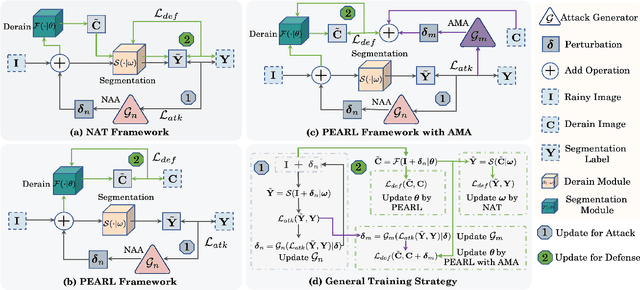
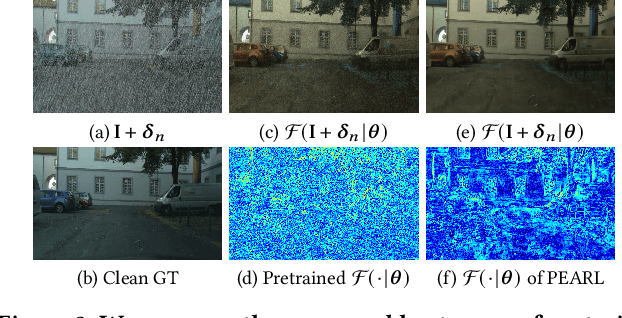

Abstract:In light of the significant progress made in the development and application of semantic segmentation tasks, there has been increasing attention towards improving the robustness of segmentation models against natural degradation factors (e.g., rain streaks) or artificially attack factors (e.g., adversarial attack). Whereas, most existing methods are designed to address a single degradation factor and are tailored to specific application scenarios. In this work, we present the first attempt to improve the robustness of semantic segmentation tasks by simultaneously handling different types of degradation factors. Specifically, we introduce the Preprocessing Enhanced Adversarial Robust Learning (PEARL) framework based on the analysis of our proposed Naive Adversarial Training (NAT) framework. Our approach effectively handles both rain streaks and adversarial perturbation by transferring the robustness of the segmentation model to the image derain model. Furthermore, as opposed to the commonly used Negative Adversarial Attack (NAA), we design the Auxiliary Mirror Attack (AMA) to introduce positive information prior to the training of the PEARL framework, which improves defense capability and segmentation performance. Our extensive experiments and ablation studies based on different derain methods and segmentation models have demonstrated the significant performance improvement of PEARL with AMA in defense against various adversarial attacks and rain streaks while maintaining high generalization performance across different datasets.
Averaged Method of Multipliers for Bi-Level Optimization without Lower-Level Strong Convexity
Feb 07, 2023Abstract:Gradient methods have become mainstream techniques for Bi-Level Optimization (BLO) in learning fields. The validity of existing works heavily rely on either a restrictive Lower- Level Strong Convexity (LLSC) condition or on solving a series of approximation subproblems with high accuracy or both. In this work, by averaging the upper and lower level objectives, we propose a single loop Bi-level Averaged Method of Multipliers (sl-BAMM) for BLO that is simple yet efficient for large-scale BLO and gets rid of the limited LLSC restriction. We further provide non-asymptotic convergence analysis of sl-BAMM towards KKT stationary points, and the comparative advantage of our analysis lies in the absence of strong gradient boundedness assumption, which is always required by others. Thus our theory safely captures a wider variety of applications in deep learning, especially where the upper-level objective is quadratic w.r.t. the lower-level variable. Experimental results demonstrate the superiority of our method.
Efficient Cavity Searching for Gene Network of Influenza A Virus
Nov 05, 2022


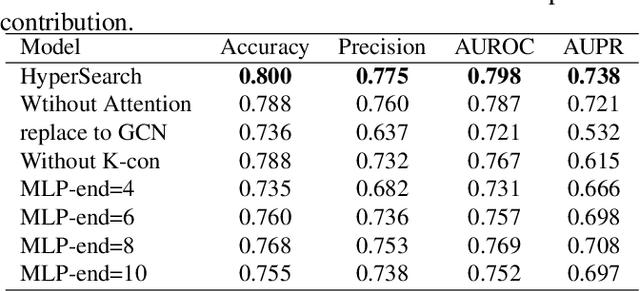
Abstract:High order structures (cavities and cliques) of the gene network of influenza A virus reveal tight associations among viruses during evolution and are key signals that indicate viral cross-species infection and cause pandemics. As indicators for sensing the dynamic changes of viral genes, these higher order structures have been the focus of attention in the field of virology. However, the size of the viral gene network is usually huge, and searching these structures in the networks introduces unacceptable delay. To mitigate this issue, in this paper, we propose a simple-yet-effective model named HyperSearch based on deep learning to search cavities in a computable complex network for influenza virus genetics. Extensive experiments conducted on a public influenza virus dataset demonstrate the effectiveness of HyperSearch over other advanced deep-learning methods without any elaborated model crafting. Moreover, HyperSearch can finish the search works in minutes while 0-1 programming takes days. Since the proposed method is simple and easy to be transferred to other complex networks, HyperSearch has the potential to facilitate the monitoring of dynamic changes in viral genes and help humans keep up with the pace of virus mutations.
LGC-Net: A Lightweight Gyroscope Calibration Network for Efficient Attitude Estimation
Sep 19, 2022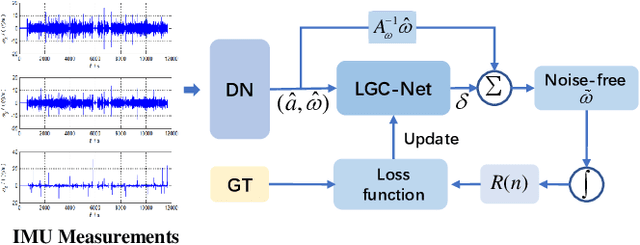
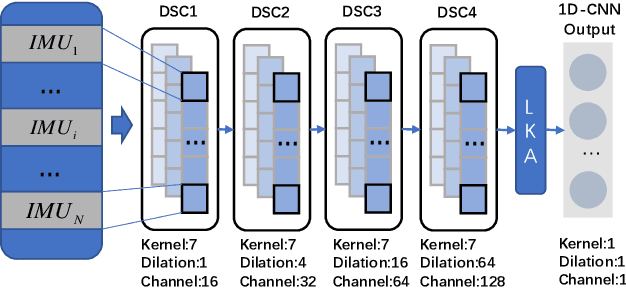

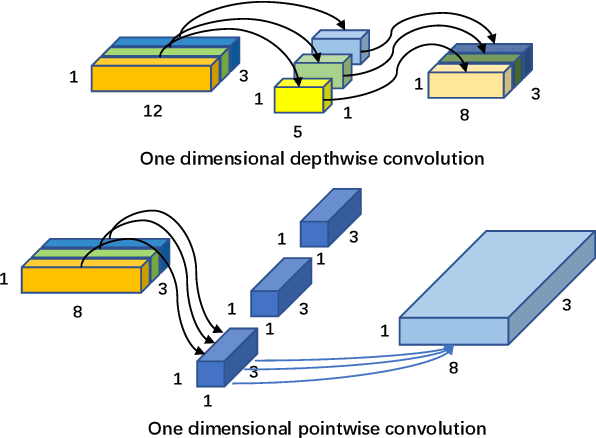
Abstract:This paper presents a lightweight, efficient calibration neural network model for denoising low-cost microelectromechanical system (MEMS) gyroscope and estimating the attitude of a robot in real-time. The key idea is extracting local and global features from the time window of inertial measurement units (IMU) measurements to regress the output compensation components for the gyroscope dynamically. Following a carefully deduced mathematical calibration model, LGC-Net leverages the depthwise separable convolution to capture the sectional features and reduce the network model parameters. The Large kernel attention is designed to learn the long-range dependencies and feature representation better. The proposed algorithm is evaluated in the EuRoC and TUM-VI datasets and achieves state-of-the-art on the (unseen) test sequences with a more lightweight model structure. The estimated orientation with our LGC-Net is comparable with the top-ranked visual-inertial odometry systems, although it does not adopt vision sensors. We make our method open-source at: https://github.com/huazai665/LGC-Net
Triple-level Model Inferred Collaborative Network Architecture for Video Deraining
Nov 08, 2021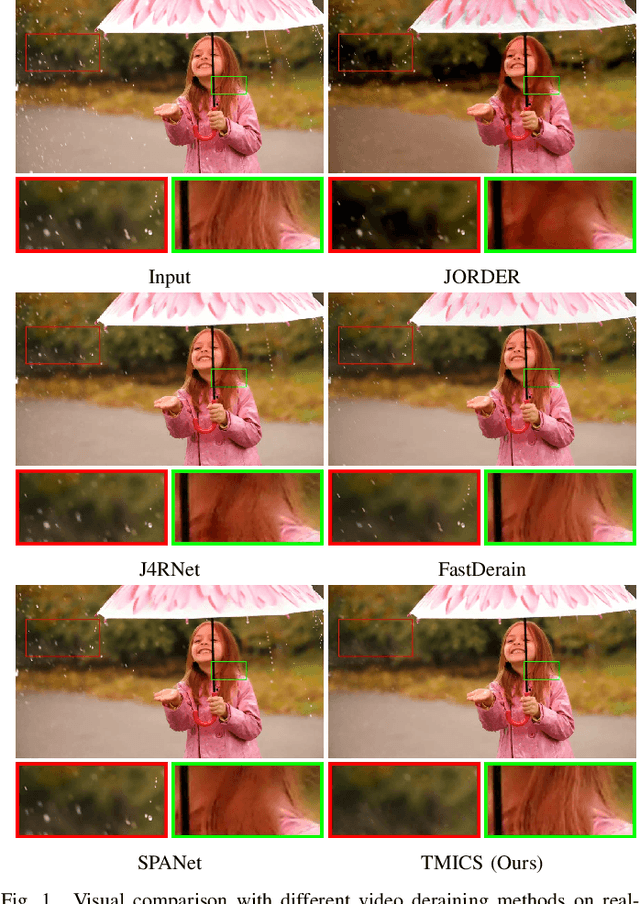
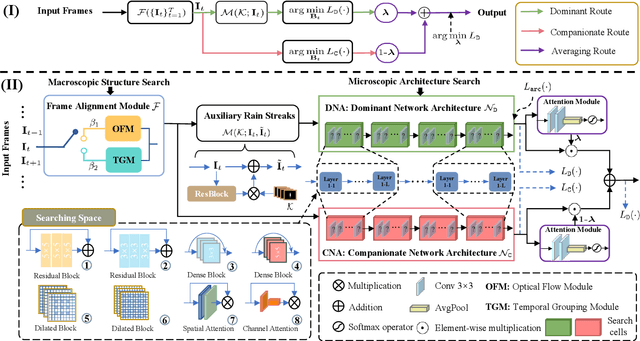
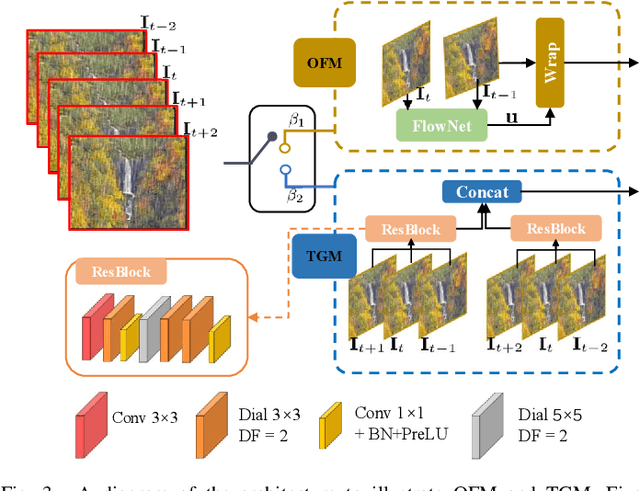
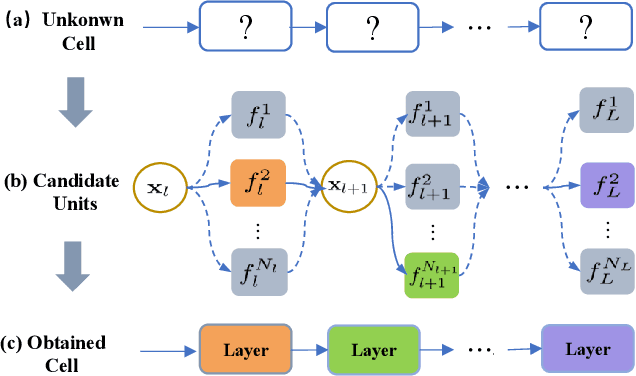
Abstract:Video deraining is an important issue for outdoor vision systems and has been investigated extensively. However, designing optimal architectures by the aggregating model formation and data distribution is a challenging task for video deraining. In this paper, we develop a model-guided triple-level optimization framework to deduce network architecture with cooperating optimization and auto-searching mechanism, named Triple-level Model Inferred Cooperating Searching (TMICS), for dealing with various video rain circumstances. In particular, to mitigate the problem that existing methods cannot cover various rain streaks distribution, we first design a hyper-parameter optimization model about task variable and hyper-parameter. Based on the proposed optimization model, we design a collaborative structure for video deraining. This structure includes Dominant Network Architecture (DNA) and Companionate Network Architecture (CNA) that is cooperated by introducing an Attention-based Averaging Scheme (AAS). To better explore inter-frame information from videos, we introduce a macroscopic structure searching scheme that searches from Optical Flow Module (OFM) and Temporal Grouping Module (TGM) to help restore latent frame. In addition, we apply the differentiable neural architecture searching from a compact candidate set of task-specific operations to discover desirable rain streaks removal architectures automatically. Extensive experiments on various datasets demonstrate that our model shows significant improvements in fidelity and temporal consistency over the state-of-the-art works. Source code is available at https://github.com/vis-opt-group/TMICS.
 Add to Chrome
Add to Chrome Add to Firefox
Add to Firefox Add to Edge
Add to Edge